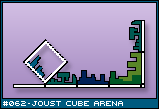|
Mechanic #062 - Joust Cube Arena |

Category: Arena | Posted: 12/04/07
A 3D air combat game where the terrain changes as the cube play area rolls across the environment. |
Welcome to my very first fully three dimensional idea. I'm not big on the whole THREE-DEE, but it had to happen eventually. Unfortunately, I've got to try and illustrate it using the old two dimensions, so bear with me.
![[cube1.png]](set04/img/entry062-cube1.png)
This is an arena game based inside of a cube. It doesn't really matter what the arena game is, but I think something like a multiplayer game of Joust is really good. Being able to fly and ignore gravity will come in handy, as you'll see later.
All battle takes place inside this cube. Each of the four walls can contain some terrain, as well as act as the "bottom" of the cube. Which direction gravity operates is entirely at the preference of the individual player, so just hitting the "gravity change" button and indicating a particular surface is enough to reorient that player such that the surface is down. This is, of course, so long as they aren't riding their flying bird, in which case gravity is largely irrelevant.
Though all action, as far as the players are concerned, takes place inside the cube, the cube itself is rolling around a 3D environment itself. This will cause the cube to constantly reorient itself as it rotates over and over again. This shouldn't be a problem since the player's perspective won't change.
![[cube2.png]](set04/img/entry062-cube2.png)
Here we see the cube doing a single 90 degree rotation. The little colored blocks represent the hills and valley of terrain on a particular surface. As you can see, where the wall meets the floor, there are two surfaces, and thus two pieces of terrain that overlap.
Each time the cube rotates, the terrain it lands on will penetrate the cube and become the terrain on that particular inner surface of the cube. When it rotates again, that terrain will remain inside the cube. As the cube twists and rotates, it will collect terrain on its six interior walls that will depend entirely on which direction the cube randomly goes. Also note that the cube can crawl up walls, and locations where wall meets floor will involve two surfaces (or potentially more).
Each interior surface has a decay rate, as it will slowly dissolve away. This decay can be increased through actions of the player (perhaps stray shots blowing away parts of the terrain?). When the cube rolls onto a piece of terrain for a interior surface which already contains terrain, it is an additive effect - valleys will be filled in and mountains could be lowered depending on what meets what. Decay will be taken into account, so a piece of terrain that is almost decayed will have much less effect on the incoming terrain.
![[cube3.png]](set04/img/entry062-cube3.png)
Basically, the cube just keeps moving slowly through this world, constantly changing it's orientation. It rolls up walls and flips up corners. The players should be able to affect which square it will move to next. This could be something so simple as simply being based on where the players are located when it flips (if the players are all fighting on the left side of the cube, it will roll left).
The world itself is non-linear and should contain surprises on certain squares, like power ups or something. Think of it like a board game where the pieces move automatically if you don't touch them long enough. A weird, three dimensional game of Chutes and Ladders...
This is a weird idea, and if I didn't know better, I'd say it was drug influenced. The trick to making it work is to find the game one plays inside the cube. My first thoughts went towards an arena game with flying creatures simply because it seemed like the constantly morphing terrain would have less of an effect - but I think it might even go so far as to have no effect, which wouldn't be very interesting. Instead, there's got to be a reason why the players would actually interact with each surface, why the terrain would matter, and why one would attempt to steer the cube in a particular direction.
One possibility is that each surface on the board could be owned by a different player, and thus when it is adopted into the cube, may contain turrets or other defensive measures that could favor one player over another. Or perhaps each surface may contribute some special rule to the field, such as increased gravity towards that surface or double points while the surface is in the cube. Whatever the reason, there should be a reason the cube is rolling around and it should matter to the players. Unfortunately, I never bothered to really come up with the game itself, since I thought the mechanic of the rolling cube required more than enough explanation for one entry.
Submitted by L
Here's a better explanation: imagine that the cube's sides are made of a gelatinous film that molds into the shape of the terrain that it lands on, and slowly flattens out when it is in open air. This provides some physical metaphor for the terrain-addition behaviour.
|
|